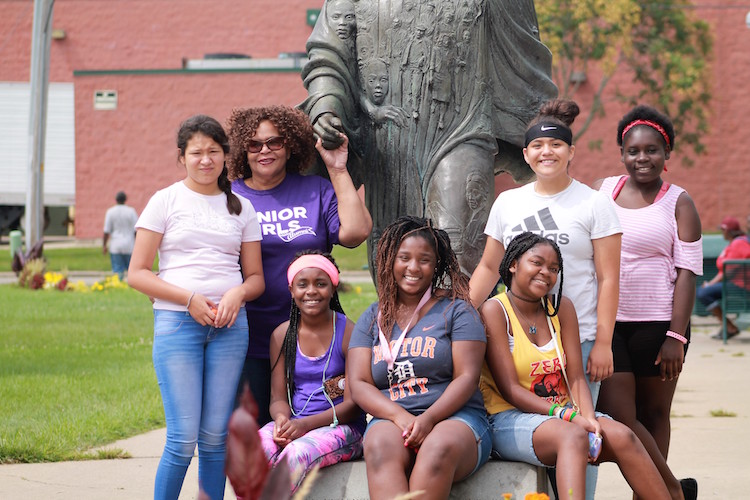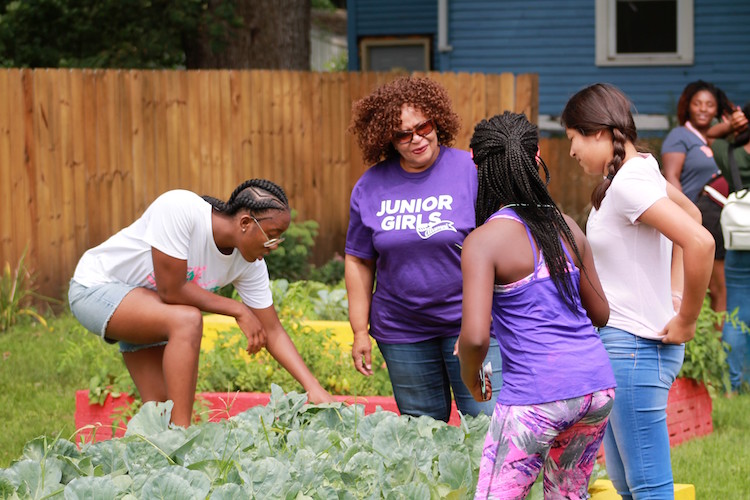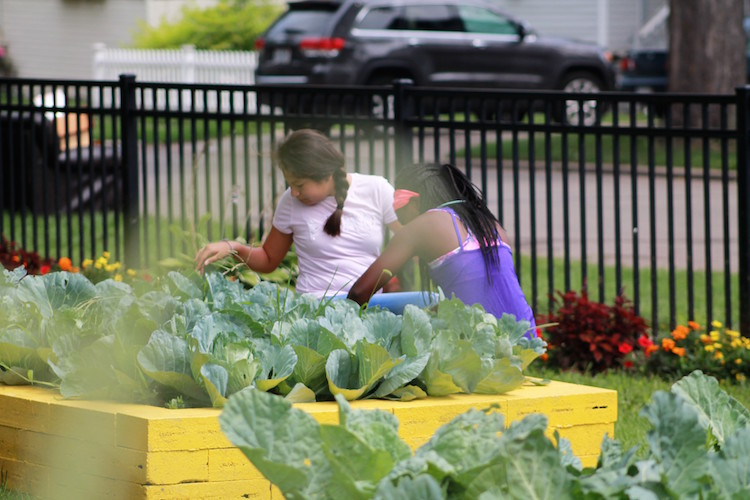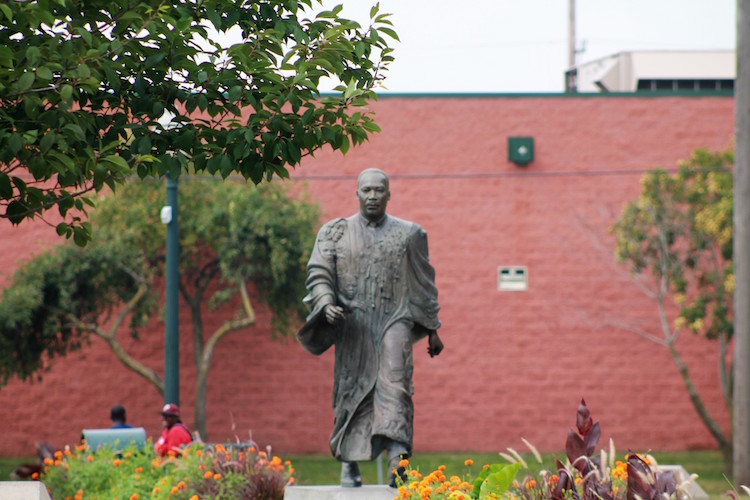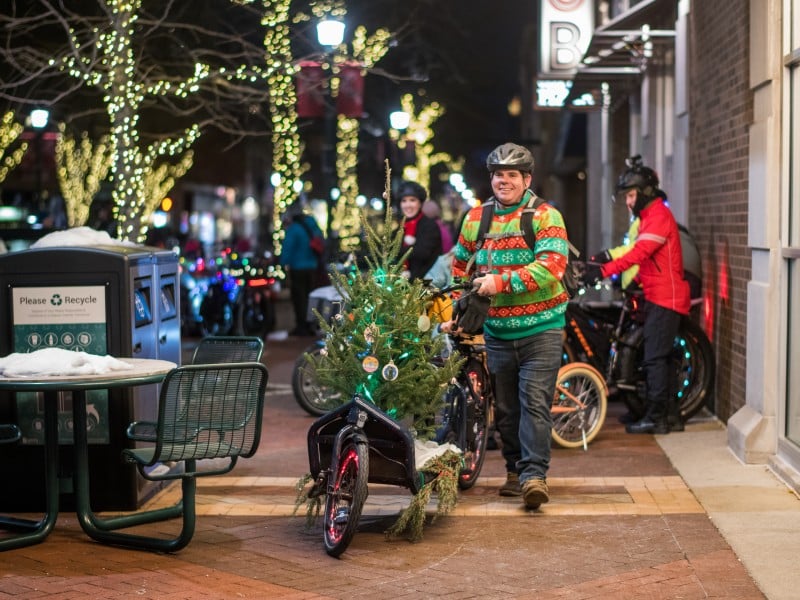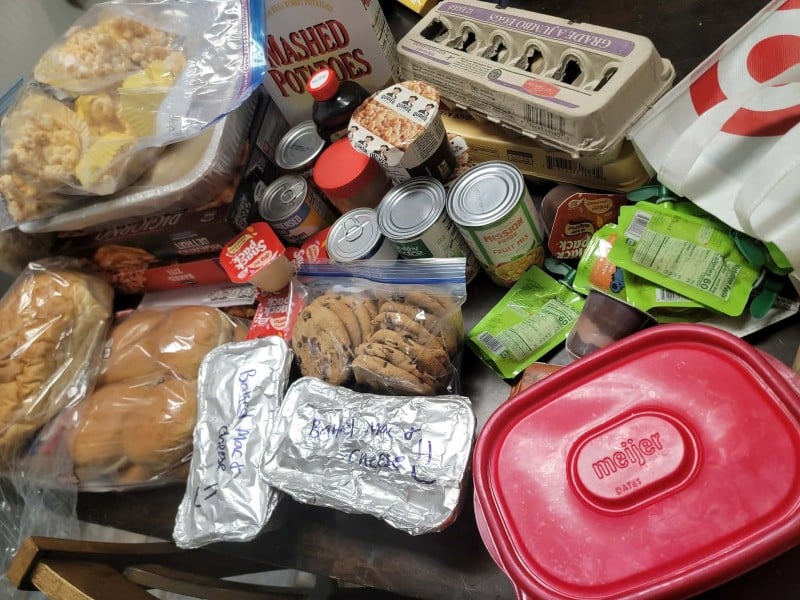Kalamazoo Junior Girls Organization is 32, thanks to Miss Pam Roland
Through after-school and summer camp programs, Kalamazoo Junior Girls learn how to be self-reliant.
Editor’s note: This story is part of Southwest Michigan Second Wave’s On the Ground Northside series.
With a soft voice and sparkly eyes that are slightly hidden behind ringlets of hair, Pam Roland, founder and executive director of the Kalamazoo Junior Girls, greets each girl who walks in the door by name.
“Your hair looks good,” she says to one girl. “Now where’s your sister?” she asks another. It’s clear that each girl, when pausing in the sunlight before stepping inside the Kalamazoo Junior Girls Organization, feels welcomed and seen.
“I love my girls,” says Roland, who is known to them all as Miss Pam, “They make me smile. They keep me young.”
Before the girls arrived for afternoon summer camp, Roland gave On the Ground a tour of the Kalamazoo Junior Girls Organization building, its home since 1989 on 1114 W. Paterson Street. “We graduated and that became our permanent home.”
Located near the edge of the Kalamazoo River Valley Trail, and only a hop, skip, and jump from the Douglass Community Center, the Kalamazoo Junior Girls Organization has served close to 7,000 girls, 8 to 18, in keeping with its mission “to inspire girls to be self-reliant women, one generation at a time.”
The Junior Girls do this through a variety of after-school and summer camp programming, in-house as well as at alternate sites, such as the Maple Street Magnet School partnering with the Kalamazoo Public Schools through the Promise Pathway to Success Program. Through health, self development, social, life skills, arts, travel and volunteering, the Junior Girls Organization has been helping to mentor and support girls and young woman on the Northside and around the city for over 32 years.
A main focus of the programming is that the girls take ownership of the activities, says Roland. Since the beginning of the program, when a few young girls first met in Roland’s house, they have been involved in all aspects of the organization, including decisions, preparation, planning and implementation.
The over 3,000-square-foot Junior Girls building includes two offices, one belongs to Rhonda Little, Program and Volunteer Coordinator and the other to Roland (“It’s beautiful, but it hardly sees me,” she says, laughing). There’s also a kitchen, gathering area for the older girls, reception area, workout and health area, large gathering area (the Vliestra Room named after the previous building owners who were also benefactors), a craft area, and the David and Betty Levene Lending Library.
While the age range is 8 to 18, most of those participating are in middle school, around the age Roland was, at 14, when an early and unexpected pregnancy, and then infant death, impacted her life.
“I truly believe this has been my purpose in life and my destiny,” says Roland of Kalamazoo Junior Girls. “There’s never enough programming or guidance that we as leaders of the community or leaders of the village can provide to our young. It’s so important that we be there to provide guidance to our up and coming leaders.
“Someone was there for me and this is my way of giving back,” she says.
One of the Junior Girls, Roland’s granddaughter, Laila Vincent, a sophomore at Kalamazoo Central High School, has been a part of the organization for most of her life. Her mother, Marvella Vincent, was an original Junior Girl at 11, when Roland first started the group. “I feel good that my grandmother is a role model to so many people,” says Laila. “And I like being with the girls. They entertain me a lot.”
On this day, following the arrival of many of the girls, Miss Pam, as mother hen, ushers her brood to the parking lot and to the large, white van where they tumble in, giggling and chatting, prepared for an outing.
“They’re going to have a lot of energy today,” says Roland. “This is their last week of camp.”
She puts on her sunglasses and off they go.
Miss Pam is taking On the Ground on tour.
First stop: Serenity and Wellness Garden on Paterson and Princeton
If you have driven down Paterson, you’ve likely seen the colorful and well-maintained vegetable garden behind a black wrought iron fence. Flourishing vegetables grow in each brightly colored raised bed, which is constructed of cheerfully painted cinder blocks.
At the back of the garden, thistle, false sunflower, and other perennials, thrive in a native planting, sponsored and donated by the Wild Ones. The plants draw pollinators and provide a wild and colorful backdrop to the well-maintained vegetable beds.
“It’s so peaceful, particularly with the native beds, and you see the butterflies and smell the fragrance,” Roland says. “You can spend hours in the place. The girls can go and learn and not realize that they’re gaining skills at the same time.”
Some of what they’ve learned includes how to construct raised beds and a privacy fence, test the soil, and consider what the plants need to thrive.
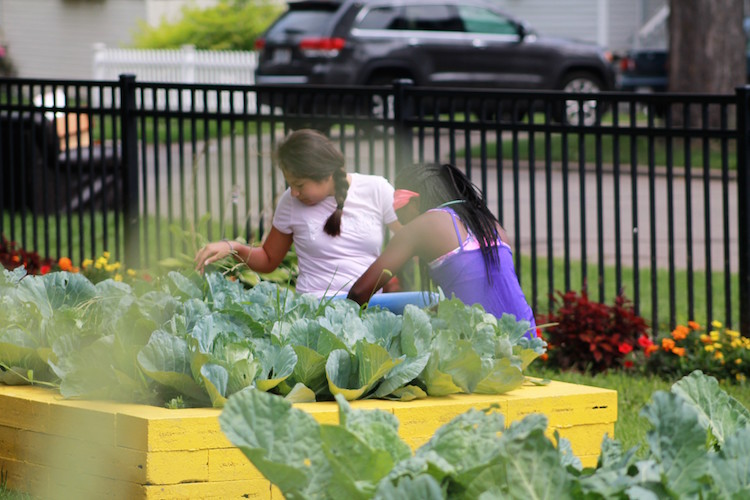
As part of a national movement called Sisters Together, Move More, Eat Better, the garden has also become a place where the girls learn to eat well. The beds are tended in partnership with some of the youth of Galilee Baptist Church, and the lot is on loan through the Kalamazoo County Land Bank’s Adopt a Lot program.
As the girls fly through the garden checking the latest developments in each bed, they ooh and aaah at their discoveries, particularly the dozens of eggplants in many sizes.
Two girls, Jona Vaughn-Hughes, who attends Maple Street Middle School, and Anna Moran, 13, who attends Milwood Middle School, each find a ripe tomato. “I had to stick my hand through a spider web to get it,” says Anna. These are the first garden tomatoes of the season. “Can we eat them?” they ask Miss Pam, who nods.
“I like the opportunities we get at Junior Girls,” says Anna. “Miss Pam and Miss Rhonda take us to different places. We go on the trail. We went to Twisters, the ice cream place, last week. We don’t just stay at camp all day like some kids do.”
Hope Escobedo, a seventh-grader at Hillside, and Mariona Moore, a seventh-grader at Paramount Charter Academy, met through Junior Girls and are now “bestest friends.” “You get to hang out. You socialize,” says Mariona. “It makes me happy.”
Amariah Patterson, 13, joins in. “It’s fun. We get to read books and play a lot,” she says, adding that she likes that she gets the opportunity to socialize with younger and older girls instead of just girls her own age.
If you’re going to be a Junior Girl, you’re going to have to get your hands dirty, explains Miss Pam. Planting seeds, both actual and metaphorical, are part of the role, whether maintaining the garden beds at the Junior Girls Building, here, or at the Martin Luther King Memorial Park.
Roland is delighted to see the many baby eggplants, though she is bemused about the scraggly corn. “There were some ears growing,” she says. “But something ate them.”
“At the end of the season, when all of the vegetables are harvested,” she says, “we’re going to have a feast.”
Next Stop: Dr. Martin Luther King Jr. Memorial Park
The girls pile back into the van and it takes off, soon pulling into a parking place in front of Martin Luther King Jr. Memorial Park (formerly Kingston Park), a well-maintained, half-acre park on Rose Street, directly across from the Metro Transit Facility.
When the park was rededicated in 1987, shortly after Junior Girls officially launched, Roland decided that the organization would become the custodial caretakers of the park when the opportunity arose. Junior Girls works with various youth group partners, such as Justice Against Bullying and the Northside Association for Community Development Young Entrepreneurs, to care for the seven flower beds in the park.
“We love this park,” says Roland. At the entrance, a large sign honoring Dr. Martin Luther King includes a collage made by Junior Girls in 1987 from pictures of King and his family cut from Ebony and Jet magazines. A print of the collage also hangs in the Martin Luther King room of the Western Michigan University Bernhard Center.
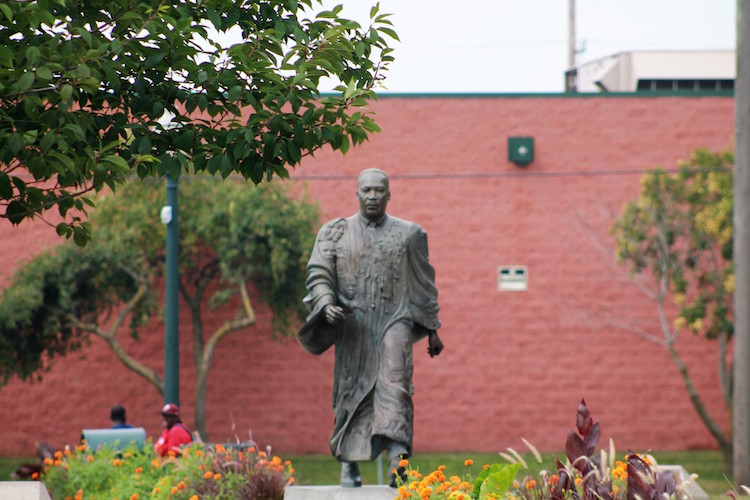
On this day, a woman is sprawled out on one of the benches. Roland stops to speak to her. At the edge of the park, several youths stand together with black garbage bags at their feet.
“During the early days, homelessness was not an issue,” says Roland, but she says she remembers seeing signs of it in the ’90s when she would discover people sleeping on the park’s wooden benches. At the time, she didn’t understand why they had no place to stay. But over the years, the park, located so close to the bus and train station, as well as downtown, has become a sanctuary for the homeless.
“Today we have a lot of challenges in that park as a result of the homeless situation. In earlier times, I just recall the girls being excited about planting,” says Roland.
“After a while, going back and forth in that park, some of the girls were seeing their own relatives hanging out. It was a learning experience for them, too. Some of them wouldn’t want to say, and then you find out. I would say, ‘Don’t be ashamed who you are and where you come from because it could be me, it could be you’.”
Roland says beautifying a space that anyone can enjoy has helped teach the girls compassion.
“We can’t judge people because they don’t have things. Some of these people might panhandle, but it’s not our place to judge them,” she says. “We don’t call them names, we don’t laugh at them, we don’t make fun of them.”
One of the joys of the park is the bronze statue of Martin Luther King, created by Lisa Reinertson, an artist from California whose father marched with King during the Civil Rights Movement.
“The sculpture is so lifelike,” says Roland, “and there are so many different people and events in his robe. The girls like finding new things. It’s like you’re really touching the man.”
After looking over the robe and checking out the flowers, Miss Pam and the girls head back to camp.
The beginnings
Roland’s mission to serving girls in her community arose out of wanting to help other young women avoid some of the painful aspects of her own youth. “When I look back, I feel like I lost several years of my development,” Roland says, “and I can never get that back.”
As a 14-year-old and middle child of five, Roland became pregnant. “You’re a woman now,” her mother told her. Though it wasn’t easy, Roland willingly gave up some of her carefree teenage ways to care for her baby, Michelle.
After five healthy months, however, Michelle became ill over three days and died. The loss was devastating.
“There’s not a day goes by I don’t think about Michelle,” she says. “I was 14. I didn’t even know what death was. I didn’t even think that babies died.”
The death catapulted Roland into a serious depression that she feels she would not have survived, were it not for professionals, mentors and caring elders, including her mother. Roland spent the next several years trying to recover.
At 17, she finished training as an administrative assistant through Parsons Business School and was offered a job with the city where she became even more familiar with some of the dire statistics related to teenage pregnancies, delinquency, and substance abuse, particularly for girls of color.
Married and with her own daughter now, when she looked out the window of her own Lola Street house, she was troubled by the young girls who were hanging out aimlessly.
“I had a conversation with my daughter,” she says. “I said, ‘What would you feel about me inviting young girls into our home and just having conversations with them, just seeing where they’re at and finding out about why they are wandering up and down the street without any vision and no focus or anything?’”
One day, Roland invited in a few girls, and then it became eight and then 25. Before long, Roland says, 60 girls were coming regularly. They met in churches and at stores, until in 1987, Roland quit her city job and launch Kalamazoo Junior Girls Organization as a nonprofit venture. It was a daring move, but one she was called to do, and for which she had the support of her husband, Elder William Roland. In the years since, the Kalamazoo Junior Girls Organization has developed into a backbone of youth support in the city, one that has now served three generations of girls.
“If I have stopped one young girl from getting pregnant or from quitting school, it will have been worth it,” Roland says.
Passing the torch
For everyone and everything, there comes a time to move on, and for Roland, that time is in February 2019, when she plans to retire.
Though she’s not yet sure who will be her successor, she has the faith that the right person will be found. She has been discussing her imminent departure with coworkers and the board, as well as the girls, for a while because she doesn’t want anyone to be taken by surprise.
“Even with my alumni, we just recently started having the conversation,” says Roland. “It’s time for someone new. We weep a little bit because we love each other. It’s not like we’re divorcing, but with time comes change, and there’s other trails to be blazed and someone else who might have the energy to do new things. So they’re looking at just who is going to be that person.
“I promise it’s going to be someone good.“
The chain of mentorship
When Roland considers where she’s been, and how she’s felt “spared,” which she credits to the Lord, as well as the many living angels who have come her way, she feels grateful to have been able to fulfill her vision of providing mentorship and support to Kalamazoo area youth.
From the beginning, Roland has instilled in her girls the idea of paying it forward.
“Back when we started Junior Girls, the idea of volunteering was new. The girls didn’t understand why they should volunteer, but when they did, they loved it,” she says. “Instead of a handout, you lend a hand up.”
Looking back, Roland has seen that value of service helping the girls grow up and lead productive, generous lives.
“When girls age out of the program, they become alumni and give time and service,” says Roland, citing a long list of impressive alumni from magistrates to university professors.
“Mentorships are so important, and it goes both ways,” Roland says. “You have to build on those relationships, you have to make the time, you have to make those phone calls and do the little things because, in the end, relationships are what matter.”

